
December 09, 2016
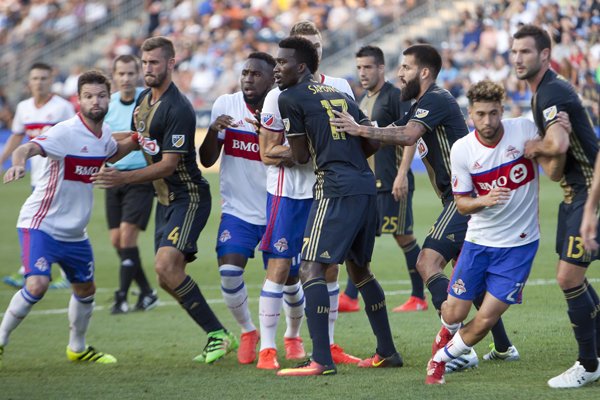 Daniel Gajdamowicz/ Philly Soccer Page
Daniel Gajdamowicz/ Philly Soccer Page
Toronto's 3-5-2 formation provides the main tactical storyline for MLS Cup 2016.
This game interests me a lot more than the last few finals.
I don't know if it's the star power, or the transformation of Toronto over the years, or the tactical allure of the matchup.
Maybe it's all three of those things. I definitely feel like there's more buzz surrounding this one.
When you look at how each team has performed in the playoffs, and during the tail-end of the season, I think there's one tactical storyline that really stands out.
For TFC, I've been complimentary of the tactical nous they've shown this year. I love the fact that they installed a new shape during the season, then trusted themselves enough to use that design during the playoffs. This is a team that played a lot of four-man defense in 2016, which you saw in both flat and diamond-styled 4-4-2 formations. When the playoffs started, they made a bold decision to roll with the 3-5-2.
One of the positive things about the 3-5-2 is that it allows you fit a lot of attacking pieces on the field. In this case, Toronto finds room for Sebastian Giovinco, Jozy Altidore, Armando Cooper, Jonathan Osorio, and Michael Bradley in the same shape. Their wingbacks are both former MLS all-stars, and their three-man backline is anchored by a veteran who also happens to be a former all-star.
This is probably how they will lineup on Saturday:
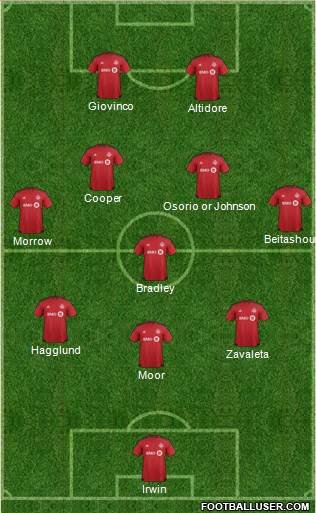
This is how Toronto played against Philly in the 3-1 playoff win way back on October 26th. The Union started well in that game, then made a back-breaking defensive error.
One of the issues with the 3-5-2 is that it's vulnerable to speed and counterattacking, which Montreal was able to prove in the 7-5 aggregate eastern conference final.
This was my favorite goal of the playoffs, which took place during the first leg of that tie in Montreal:
The first Montreal goal, Oduro #MLSCupPlayoffs pic.twitter.com/AomOAeanNx
— Champagne Soccer (@SoccerChampagne) November 23, 2016
When you watch the replay, you see that Patrice Bernier doesn't need to pick his head up to play that pass, because he already took a look ahead and he already knows where Dominic Oduro is going to make his run. Bernier is a veteran player who understands that the defensive channels have different locations in a 3-5-2, which are actually more narrow and closer to the middle of the park.
I'll try to illustrate what I'm talking about:
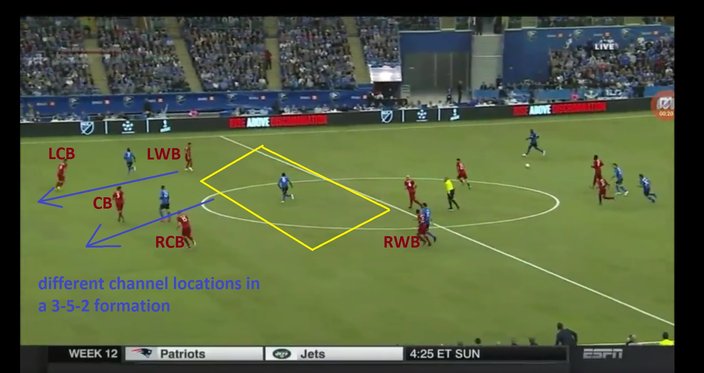
The purple arrows show those different channel locations. In a normal four-man defense, you're splitting a center back and fullback, which will take you a bit wider, probably five to seven yards outside of the penalty area.
In this case, Montreal can dump into the corner or try to split Nick Hagglund and Drew Moor, which is what Bernier ends up doing.
Here's another screen grab that shows the progression of the play:
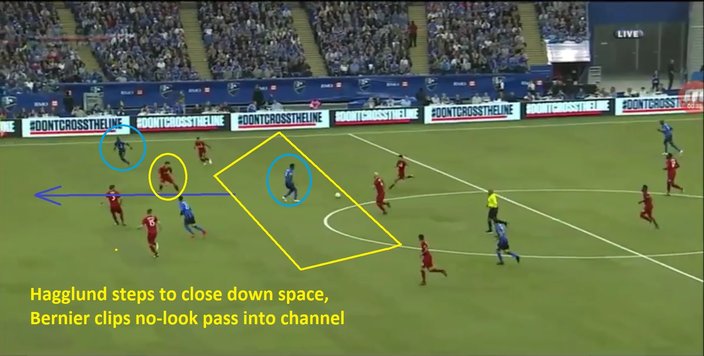
Montreal is able to score with just two touches and two passes, starting with a ball from the right back that splits not only the forward line but the midfield line as well.
That's the biggest issue with Toronto's 3-5-2. The center backs have trouble with speed, especially if midfielders can get into the pocket between Bradley and Moor.
Seattle was not a 4-3-3 team until this season, which was a change that Sigi Schmid made after the departure of Obafemi Martins.
Everybody knows that they struggled early. They couldn't score, they didn't show much chemistry, and they just didn't seem to be playing in a system that really fit.
The addition of Nicolas Lodeiro has obviously improved the team, and they've got a legit playmaker in the hole instead of trying to shoe-horn Clint Dempsey into that spot.
Brian Schmetzer approached the Colorado series with slightly different ideas in each game. In the first leg, at home, he played Lodeiro on the right with Erik Friberg in the number ten spot. Lodeiro spent much of the game sitting in a central area, with Friberg sliding out to the right, so that design ended up being a wash.
In the second leg, he started Lodeiro centrally and added Andreas Ivanschitz to the lineup in a wide role. Jordan Morris played on the other flank with Nelson Valdez up top.
If I'm Schmetzer, I'm sticking with that idea for Saturday, and playing something like this:
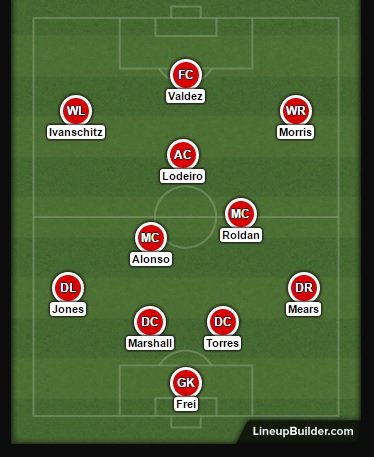
I want Morris on the wing because he can run at Toronto in the same way that Oduro did.
Morris is Seattle's best speed option, and playing him up top is just going to get him tangled up with Moor in positions that don't really benefit anybody. He's a good back shoulder runner, but he's better when he can get the ball and push forward with a head of steam.
These are the kinds of plays that threaten the 3-5-2:
Another look at this fantastic run by Jordan Morris to set up Lodeiro for Seattle's 2nd goal! #MLSCupPlayoffs https://t.co/lqUkLj678j
— Scouted Football (@ScoutedFtbl) October 31, 2016
Granted, that's a run against a four-man defense, but it starts from inside his own half. He turns on the jets, then shows a lot of smarts to pick his head up and find the left-footed pass across the goalmouth for a Lodeiro tap-in. You don't always see that kind of composure from young players in wide areas, who sometimes lack the ability to play the final ball. You might recall Fabian Castillo's struggles in that area when he first joined FC Dallas. Even Oduro left something to be desired with his finishing and final pass during the early part of his career.
Another thing that Morris does well is the timing of his inside pinch and diagonal run.
On the tap-in goal he scored in the first leg of the western conference final, I don't think he got enough credit for splitting the center backs prior to Cristian Roldan's shot that came off the post.
WATCH: Jordan Morris equalizes for Seattle after Kevin Doyle’s away goal for Colorado (via @FoxSoccer) https://t.co/MCNi5m3FWQ #SEAvCOL
— Planet Fútbol (@si_soccer) November 23, 2016
When you make that kind of diagonal, it's not just about providing a passing option into the channel, it's also about making defenders honor your presence, which opens up space for a teammate.
In that play, Sebastien Le Toux is trying to catch up to Roldan from his wide midfield position. Jared Watts is in a position to step up and close the space, but he has to respect the run that Morris is making behind him. When Watts finally pauses to address Roldan, Eric Miller collapses a bit, keeping Morris onside when the shot is taken. Morris gets an easy goal from the rebound.
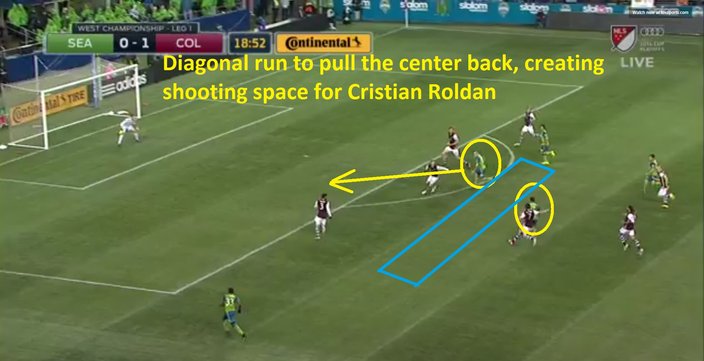
In this case, that moment of pause allows the shot and leaves Morris unmarked on the rebound.
For me, the key is Toronto finding a balance with that 3-5-2. We know what Morris can do in wide areas, and we know that Lodeiro oozes chance creation when given space to operate. Michael Bradley has to keep an eye on that pocket and protect his center backs.
Otherwise, this should be mostly straightforward. Both teams are about the same in dead ball situations. They play well in wide spaces and have difference makers all over the field. I expect an entertaining, attack-minded game.